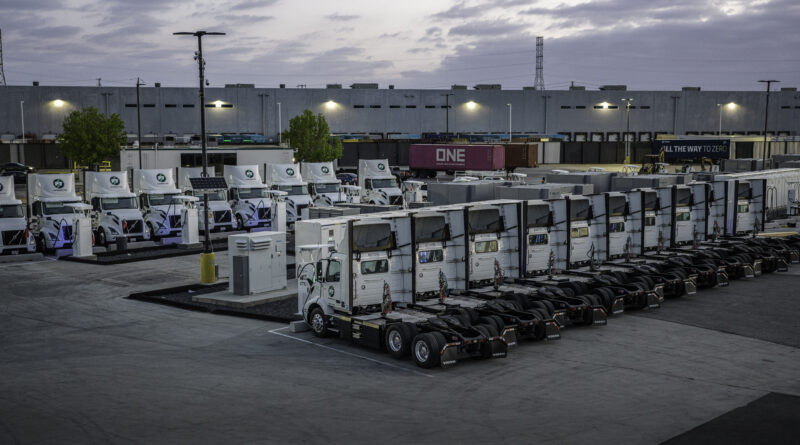New EV Depot Capable Of Charging 96 Heavy-Duty Electric Trucks Launched By Prologis/Maersk
Prologis and Maersk just launched an EV charging depot that will be able to charge up to 96 heavy-duty electric trucks at the same time. Performance Team, which is part of Maersk, will be using a fleet of Volvo VNR Electric trucks at the depot. These are tractor trailers with a range of about 240 miles per charge and they can recharge to about 80% in 90 minutes. The new truck charging depot is located near the ports of Los Angeles and Long Beach.
Approximately 30,000 trucks are registered with these ports and most are diesels. To put it very mildly, diesel exhaust is not good for human health.
According to the US EPA, “Exposure to diesel exhaust can lead to serious health conditions like asthma and respiratory illnesses and can worsen existing heart and lung disease, especially in children and the elderly. These conditions can result in increased numbers of emergency room visits, hospital admissions, absences from work and school, and premature deaths.” Such emissions obviously also contribute to climate change.
So, replacing big, polluting diesel trucks with electric ones that have no direct emissions reduces harmful air pollution. Of course, these large electric trucks must have EV chargers and ones that are fast enough and reliable. Installing dozens of new chargers is greatly helpful to the goal of cleaning up Southern California air. The new EV charging depot is powered by the nation’s largest EV truck microgrid.
Henrik Holland, Global Head of Prologis Mobility, answered some questions about the new EV chargers for CleanTechnica.
Can you please describe in basic terms that lay people can understand, what the nation’s largest EV truck microgrid is, and how it works with your new EV truck charging depot?
This microgrid is a network of electrical generators and loads that may be grid-connected but can operate independently of the local grid. It’s a small power grid that has its own source of energy and can operate on its own. It has 2.75 MW of fuel-flexible linear generators paired with 18 MWh of batteries to provide up to 9 MW of charging capacity. The site can charge 96 electric heavy-duty trucks simultaneously.
When will it be operating at this capacity, and about how many trucks will be charged daily at the depot?
The site currently has 32 chargers in operation, it will be fully operational by the end of June, in line with the vehicle delivery schedule. Once fully operational, the site can charge over 300 trucks daily.
Is there an average charging rate for each charger in KW? Or do you have an estimate as to how long it will take to do a full charge?
The site can charge most trucks to 80% in 90 minutes.
The project took 5 months to construct — where is the demand for the EV chargers coming from?
Against the backdrop of California’s requirements to end the sale of diesel trucks and move to electric drayage trucks by 2035 and electric heavy-duty trucks by 2045, companies like Performance Team are investing in charging infrastructure to support operations. This project is a key connector in the infrastructure needed to meet the state’s goals.
Is any of the electricity for the EV truck chargers coming from clean, renewable sources such as solar power?
This On Demand charging solution helps get battery-electric fleets on the road faster when immediate grid power is not available while providing emissions performance that is comparable to or better than the local grid. The linear generators, using natural gas, produce near-zero NOx emissions (96.7% less NOx emissions than an equivalent diesel fleet operation).
Onsite solar would not be able to provide the power needed for such a significant EV truck fleet charging installation. For this project and size, we would have needed over 100 acres of solar and a massive battery to have this operate 24/7. At this site, we had 3 acres available.
We are working closely with the LA Department of Water and Power to determine when the grid will be ready for us to plug in. We are also reviewing the availability of hydrogen.
Does the microgrid have its own energy storage in the form of batteries?
This site has a 6MW /18 MWh battery.
About how many jobs were created during the 5-month installation phase and how many for operating the new depot?
Prologis supported approximately 37 direct construction jobs and potentially up to 111 total jobs when considering indirect and induced employment during the installation phase of what one of the largest construction jobs in EV charging infrastructure in North America. In the operating phase, we expect several hundred jobs to be supported, both directly and indirectly. For example, 300 trucks with two daily shifts operational mode require at least 600 drivers.
What kind of electric trucks will use the new charging depot?
The site is compatible with any typical North American electric truck. Being close to the ports will lead to a heavy usage of drayage trucks.
The new depot is located near ports. How much cleaner will the air there be using dozens of electric tractor trailers in place of diesel trucks?
This operation on average will deliver 97% less NOx emissions, the main cause of smog, as compared to diesel operations.
Have a tip for CleanTechnica? Want to advertise? Want to suggest a guest for our CleanTech Talk podcast? Contact us here.
Latest CleanTechnica.TV Videos

CleanTechnica uses affiliate links. See our policy here.

